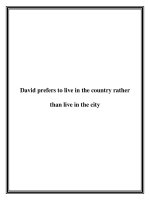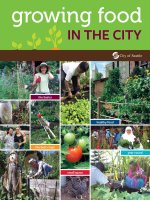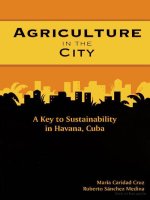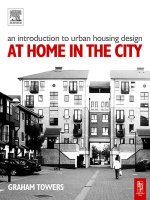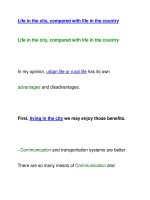2787 conversation corner where in the world 3 the city
Bạn đang xem bản rút gọn của tài liệu. Xem và tải ngay bản đầy đủ của tài liệu tại đây (485.06 KB, 2 trang )
Your guess: 1.
2.
Where in the world could this city be?
Explain your guesses.
Where could you stay if you visited this city?
Think of several options.
What can you see in the pictures?
Describe them as detailed as you can.
What kind of animals could possibly live in this
environment?
Do you prefer the city or the countryside?
Explain why.
What dangers could you encounter when going
there?
More and more people migrate from the
countryside to the city. Why?
Would you like to visit this place?
Explain why (or why not).
What are the biggest cities in the world?
Brainstorm and make a top 5.
Name ten countries where you could find
similar cityscapes.
How could we reduce traffic problems in big
cities? Think of a few strategies.
Tell the class where you plan to go for your
next vacation and what you can do there.
What could you see or do here?
Make a list of possible activities.
What are the major tourist attractions in your
city or the city nearest you?
How could you get there and how would you
get around once you are there?
How do you think local people make a living?
Tell the class about your last city trip.
Where did you go? What did you do?
What could threaten this seemingly orderly
and attractive city?
Teacher Notes
•
•
•
•
This answer key is deliberately kept concise since the idea of these Conversation Corners
is to talk rather informally and share information, not being given all the information by
the teacher. BTW, the conversation should focus more on expressing opinions than giving
correct answers.
Students could be given the opportunity to do some research on the Internet to find
more information and answers to the questions.
Also, students could prepare questions they were unable to answer and give a short
presentation during the next lesson.
Have a dictionary at hand (or an Internet connection) if possible so students can look up
new vocabulary.
Buenos Aires, Argentina
Focus on key vocabulary and encourage Ss to
use full sentences. E.g. There is a shopping
street/walking street with many shops in the
small picture. A wide, tree-line lane/avenue
runs through the city in the big photo.
Other vocab: skyscrapers, flags, etc.
Hotel, (youth) hostel, (rented)
apartment/flat, etc.
Squirrels, sparrows, mice, rats, cockroaches,
pigeons, etc.
Car accident, getting robbed by pickpockets,
losing your way, getting mugged, etc.
Answers may vary.
Answers may vary.
They are usually looking for a better life, a
better-paid job and think the future will be
better in the city.
By population (www.worldatlas.com/citypops.htm)
1. Tokyo, Japan - 32,450,000
2. Seóul, South Korea - 20,550,000
3. Mexico City, Mexico - 20,450,000
4. New York City, USA - 19,750,000
5. Mumbai, India - 19,200,000
6. Jakarta, Indonesia - 18,900,000
7. Sáo Paulo, Brazil - 18,850,000
8. Delhi, India - 18,680,000
9. Õsaka/Kobe, Japan - 17,350,000
10. Shanghai, China - 16,650,000
Better public transport, inner city car tax,
more bicycle lanes, restricted car access
(odd/even number plates), dedicated bus
lanes, increase petrol prices, carpooling etc.
Sightseeing: parks, churches, museums, old
neighbourhoods, etc.
Shopping, going to the cinema, going out
(clubs, restaurants, pubs) etc.
Get there by plane, car, train, bus etc.
Get around also on foot, by taxi, bus,
subway/underground, etc.
Answers may vary.
Basically any (semi-developed) country with
major cities fits this profile.
Answers may vary.
Answers may vary.
White collar jobs, tourist & hospitality
industry (restaurants, hotels, travel agencies),
civil servants, teachers, police officers etc.
Pollution – air pollution, noise pollution, waste
water; lack of drinking water, littering,
runaway development, lack of building and
safety standards, earthquake, overpopulation
etc.
